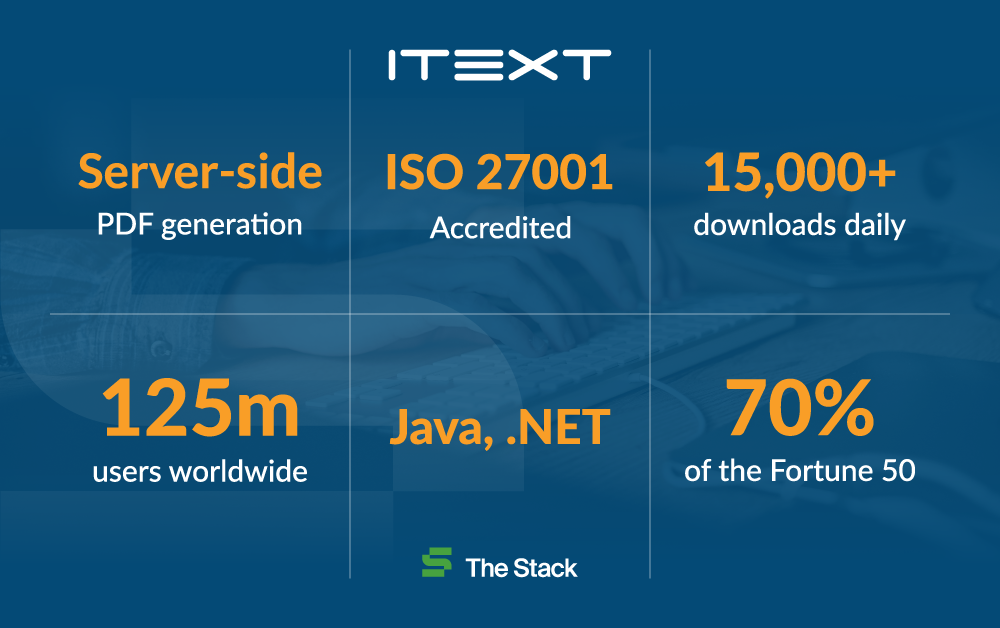SPONSORED -- Start talking about PDFs too excitedly and some of your audience may nod off. Yet PDFs remain critical to many organisations’ workflows and not everybody’s napping. With over 15,000 downloads daily, opensource company iText -- which specialises in PDF software for large enterprises -- boasts a mighty 125 million users globally. Investors are paying attention too: an investment vehicle of Peter Thiel – PayPal investor, Palantir co-founder, first external investor in Facebook and a man with a notorious nose for an investment opportunity – has thrown his considerable weight behind the Belgian company via Crescendo Equity Partners.
iText offers a core PDF software library under the AGPL license, with commercial licensing for customers that do not wish to comply with AGPL and want to keep their source code private. Its software is used by everyone from banks to governments; utilities to multinational consultancies. So why is the appetite for server-based PDF generation so strong? How do you innovate on top of such a well-established document standard? And what’s driving iText’s surging growth (it grew at over 50% during its last quarter).
The Stack’s Ed Targett sat down with iText CEO Gary Fry to learn more about a critical yet often overlooked part of the B2B world; hear about iText’s flurry of recent patents; and get a preview of its new enterprise products as the company sharpens its focus on adding value for customers looking to do more with their data.
“Gary, for those new to the company, what is iText?”

“In simple terms, we enable enterprises to add workflows around PDF into their applications. If you're a bank, or insurance company, or utility, or a government agency, then at some point you're going to want to use the standard ISO PDF to communicate with your audience. We’re the leading supplier of server-based PDF rendering software. But we also do a lot of other things. As well as serving out high quality PDFs in volume, we enable other functionalities; that may be conversion from HTML to PDF; it may be redacting information or cleaning up the fonts and calligraphy in different languages where the font is slightly more complex; it may be optical character recognition (OCR) in PDF and taking data out; or integrating digital signing.
iText is the provider of the PDF technology that our customers will embed into their own applications. It's very much an SDK and toolkits that that we supply to our customers, who represent a large developer community within enterprises. Another big use cases is in the PDF/A archiving standard. A document in Word format etc. will not stand the test of time in terms of its digital footprint. There's only one standard that is used in electronic archiving, which is PDF/A – where we give the ability to add volume, speed, and high quality.”
“What are customers serving PDFs for, at such scale?”
“Interactive banking applications is one area: customers request a bank statement or tax record through their banking application, that request goes into a back-end server, which looks for the data, and pulls it out in the PDF format for you. Another good example is a very large consulting firm that provides unique statements for employee’s pensions. All of that data is held in its back-end systems. When an employee wants to know their pension valuation at a point in time, the application takes that data, processes it through an iText SDK and then renders it as a PDF for employees when they want it. There are literally millions of case studies: utility bills; PDF receipts for online shopping; digital signatures; anything that touches a PDF can be server-generated by us.
PDF isn’t going anywhere: as a standard specification to render or display information it’s widely used and so widely useful. For a Word document, for example, you need the Microsoft application to work with it. And depending on what PC you're on, or what version of Word, it will display in a slightly different way. A PDF will always render in exactly the same way however you’re viewing it, irrespective of the type of reader.”
“This is not a new technology. How do you continue to innovate?”
“Firstly, via the PDF standard, which is always evolving. We’re continually building that standard as part of a committee and the community driving it forwards. Adding new functionalities for our customers is a big part of our focus. We’ve just had four patents approved for blockchain applications, for example.
If you think about what we do as a B2B company providing an SDK to large enterprises, we take data and we create a meaningful document from that data. That also can go the other way. Our product iText pdf2Data allows customers to extract data from PDFs and put it back in the database again. Invoices is a great example. Enterprises get thousands of scanned invoices: being able to automate extraction of the customer number, the purchase order number, the total value the bill of materials is very powerful – particularly as the market moves more and more into the machine learning world where accessing data like this is so important.
We also have some really clever technology that identifies where certain data fields are and extracts them, even if the document is templated differently. We have over 7,000 enterprise clients worldwide that we’re adding value for: most of the major banks, most of the major government agencies, insurance companies, utilities; anyone that has a large document-centric workflow will probably be a customer of ours. And if they're not a customer of ours, they're probably using our technology and we hope will be a customer of ours in future.”
What’s your approach to open source?
The origins of the iText code date back to 2000 and from the start it was created with an open source model. We have a huge user base of developers – there’s around 15,000 downloads of our software every day; for a small company, that’s pretty extensive – and we support users with our own knowledge base which is continually updated, because the community is a massive resource. We’ve seen people go from one company to another and build iText-based workflows into their systems as the most effective way to get that data out. So our approach to OSS is really simple: we use AGPL licensing which allows for a customer to use the software free of charge [a strong copyleft license that enforces open source on all components derived from any previous work].
The AGPL licencing model is very well known by enterprises, it's not a surprise to them. And that model allows an enterprise customer build an application free of charge without any licencing and only come to us when they deploy. But we have an add-on strategy too. Our core library that everything is built around is open source. But we have a number of different add-ons to our products that have to be commercially licenced.
We get three types of customers, ultimately. One is the open source user, abiding by the AGPL. We’re always support them: they’re central to the community; sometimes they want additional functionalities and come to us because it’s a lot easier to build on a library you’ve implemented. Then we have larger customers that license very early on and which are heavily focussed on compliance and want to control costs. Then we have customers that have been using iText for a while and then realise through an audit that perhaps they’re not compliant. They come to us saying ‘we’ve been using your software for a couple of years and would like to license it’. We look very favourably on those customers, work out how they work, how we can support them with a really useful roadmap going forwards that they’re getting value out of; it’s a very developer-friendly model.
You joined a year ago. What’s the big focus for you as a CEO?
A big focus has been shifting from a perpetual business model to a recurring license business model – and we’ve just come off one of our best quarters ever. The company's been growing at over 30% a year -- this quarter was close to 50%. The first year’s focus has really been to build the team and make sure our customers are still delighted -- we have a 95% customer satisfaction rating that the team should be proud of.
In the past I've done turnarounds where you take a broken company, and you fix it. iText is not that: it’s an incredibly successful company that needed a little direction and inspiration.
As a leader you don’t want to break an entrepreneurial spirit, the teamwork, the collaboration; all the things that you get in in a relatively small company. So my focus is a bit of a mix of creating maturity in processes in team instruction, while allowing that entrepreneurship and progressing brilliant people. The company is full of great talent; nurturing that talent and bringing it out is a key part of my role. I'm an enabler of great people: there's nothing unique in what I do [as a CEO]. I'm not a product visionary, but what I can hopefully do is nurture that talent and bring the right people together, to keep this this impressive growth path going.
“If you had to pick three current priorities, what would they be.
The first is talent. We're in the middle of expanding our development team. Trying to find yet great engineering talent in Belgium is competitive, so we're looking in the UK, in the US; we're looking at Spain, Portugal, Eastern Europe; anywhere the right talent is there, we'll bring them on board. We have hubs in Ghent, in Boston, and Singapore. But we were very much embracing the remote working trend. We have a big hiring drive ahead of us, so onboarding and keeping people on board and making sure they’re nurtured is a priority.
Acquisitions are also a big play for us. In AI, machine learning sometimes you have to buy yourself into those sectors: we're actively looking for companies in those spaces that allow us to augment our processes and add greater value to our customer base. Thirdly, continued growth: a focus on sales, execution, and making sure that we delight our customers, support our customers, and ensure they want to continue working with us.
We're by far the biggest player in the enterprise space and we're focused what we do really, really well – being the PDF SDK for the backend, while building on machine learning, data extraction plays. We have a huge customer base of people using us to create documents from data sources, but the market is also looking at this this static unstructured information in documents and looking to take it back to data again: data to documents and documents to data: that's the value we have as a company and where we’re doubling down.”
This article was sponsored by iText








